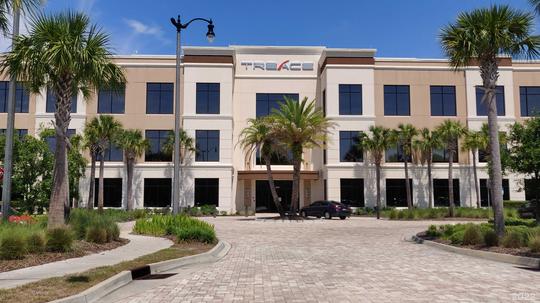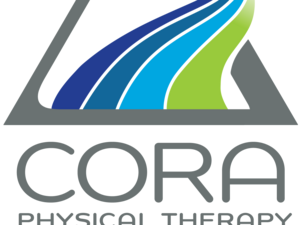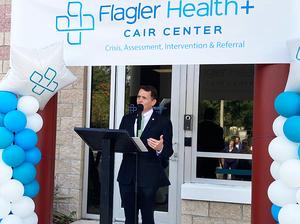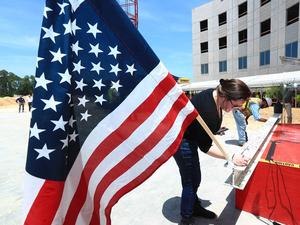
Since it was founded in 2014, Treace Medical Concepts, Inc. (NASDAQ: TMCI) has been pursuing dominance in a niche market that it believes is untapped and underserved.
“Some companies grow by offering everything to everyone,” said Mark Hair, chief financial officer of the Ponte Vedra Beach-based orthopedic medical device company. “We are really, truly focused on the bunion and concomitant issues in the foot.”
In the past four years, the not-yet-profitable company has been growing aggressively, its revenue increasing 125% in 2018, 122% in 2019, 46% in 2020 and 65% in 2021, according to an investor presentation in June 2022. Last year, the company brought in $94.4 million in revenue, according to documents filed with the Securities and Exchange Commission. In the first quarter of 2022 alone, its revenue was $29 million, up 55% from the same quarter the previous year.
As the medical technology company grows, so, too, is its headquarters. At the end of July, the company plans to hold a ribbon cutting at a roughly 120,000-square-foot facility in Nocatee at 100 Palmetto Park Place, just a few miles from its current, roughly 25,000-square-foot facility at 203 Fort Wade Road.
Hair said the move is meant to accommodate the company’s expanding operations, to provide a space for surgeon training at its home office and to add room for the company’s growing employee base. It currently has over 300 employees.
The move to the new facility will begin in August.
The bunion business
Bunions — painful bumps at the joint of the base of the big toe — are surgically treated through two types of procedures: osteotomy and Lapidus fusion. Osteotomy, which involves shaving off part of the protruding bone, accounts for roughly three-quarters of bunion surgeries, according to the medical device company’s June 2022 investor presentation.
Lapidus fusion, which correct the problem by fusing the protruding bone’s joint with a bone in the midfoot, accounts for the rest. While that method has a lower rate of bunion reoccurrence, it also has a longer recovery period.
Treace aims to solve these problems by improving the Lapidus fusion procedure — thus leading to a shorter recovery period — and providing a single set of guidelines and instruments for surgeons to perform the operation, where there currently isn’t one.
“Instead of making this a very complicated, difficult freehand surgery, [Treace] can really standardize that process in the way they treat bunions,” he said.
According to a June 2016 study in the Journal of Orthopaedic & Sports Physical Therapy, more than 64 million Americans have bunions that lead to painful walking. Treace, in its investor presentation, claims 4.4 million of those seek medical treatment annually, while 1.1 million become surgical candidates. Only 450,000 surgical procedures, however, are actually performed, it says, representing a $2.3 billion market.
Treace sees a $5 billion market opportunity in the 1.1 million who are surgical candidates but may not undergo surgery.
Aside from its flagship, Lapiplasty 3D Bunion Correction, Treace also launched its less invasive Lapiplasty Mini-Incision System, for which Hair said it can charge a premium, in the fourth quarter of 2020. It launched its Adductoplasty Midfoot Correction System, meant to correct deformities formed elsewhere in the foot as a result of the bunion, in the third quarter of 2021.
How it’s going
Treace Medical Concepts went public in April 2021, looking to raise around $90 million. The company wound up raising $107 million.
With that infusion of capital, Hair said Treace is investing in their direct sales channel, in surgeon and patient education, and in research and development to introduce new products, iterate existing products and improve the Lapidus fusion procedure as a whole.
The company has not yet turned a profit since going public, and it has not given specific dates for when revenue might begin to exceed expenses. In the first quarter of 2021, for instance, the company reported a $9 million loss. Hair said expenses will outpace revenue in 2022.
Investors were not thrilled with the company’s reported earnings in the first quarter. After trading at around $19.50 for at least a month before the May 5 earnings call, the stock plummeted, eventually reaching a 52-week low of $12.48 on May 11. The stock has not fully recovered, trading at around $13.50 as of June 14, though the Nasdaq Composite — an index of mostly technology stocks — has also dropped about 12% between May 5 and June 14.
Macroeconomic headwinds aside, Hair is bullish on Treace’s future, predicting the initial investments will bear fruit once its team of sales representatives becomes more effective in the next year or two and as surgeons increasingly use its products.
In 2018, according to Treace’s investor presentation, only 0.8% of the 450,000 bunion surgeries performed in the United States used Lapiplasty, with 554 surgeons out of 10,000 using it. In the first quarter of 2022, 4.3% of surgeries use Treace’s products, with 1,901 surgeons operating with them. Both of those figures — representing Lapiplasty's percentage of U.S. bunion surgeries and number of U.S. bunion surgeons — increased each year from 2018 until 2022.
“We definitely have big ambitions,” he said. “We’re optimistic about what we’re able to do.”








